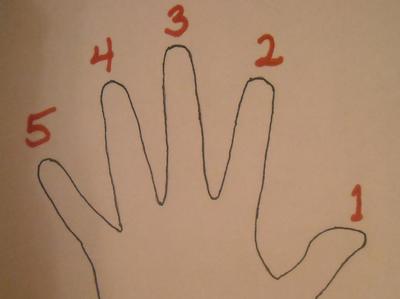I have recently begun teaching an 8-year-old girl with mild autism to play the piano.
by Veronika
(Lakeland, FL)

She has had 4 lessons so far. At the first lesson, she showed me that she could press down on the keys, but only with the 2nd finger of her right hand.
So I thought a good way to begin was to get her to press down on the keys with all 5 fingers of her right hand, and then teach her to do the same with her left hand.
I got an outline of a right hand and wrote each finger number above the finger in red. I also wrote large, red numbers (1 to 5) on index cards.
Then I discovered it helped to position the bench perpendicular to the keyboard. She sits in front of the keyboard, and I straddle the bench behind her. This way, I can hold her left arm down while taking each of her right-hand fingers and pressing them down on the keys.
I repeat 1-1-1 for the thumb many times. Then I say, "play 1". and see if she presses down a key with her thumb. If she does not do it, we repeat it again many times. If she does it, she gets a reward (small pretzel or popcorn), and we move on to another finger, and repeat the pattern.
After she learns to play with all fingers and the number of each finger, then I want to introduce counting beats. Beats will be in blue so that she does not confuse finger numbers with beat numbers. Do you think this will work?
After that, I want to introduce the note names on the keyboard. These will be in black (A to G). I think that teaching her to read music on the staff should come much later. I think that she will do better if she learns to play by ear first, and read music later. Please help me stay on track with this student. I will very much appreciate all of your help!
Dana:
Hi, Veronika,
I like the care you are taking with details. The different colors for different tasks sounds like a very good idea, to be repeated each week until they are retained.
My main concern is that the student has no songs to play. At least a few notes of something that she already knows. Twinkle Twinkle, or Jingle Bells? Or Mary Had a Little Lamb... not the whole song or even a whole phrase, but a few recognizable notes. Or on the black keys, Do You Want to Build a Snowman? from "Frozen."
I agree with you about learning by ear, TOTALLY. Encourage her to "copy-cat" what you are playing, and to learn to enjoy making tiny melodies with just a small range of notes, while you play background chords... or have her play a chord shape over & over while YOU make up a melody.
A problem you might encounter just focusing on finger numbers & piano key names is that even if she knows the names & numbers, she may not have the finger facility to use them in a meaningful way yet. Personally, I would focus on learning finger movement PATTERNS - scales - as well as names for things.
An example: Hold the hands up, palms together, and say the finger numbers "1, 2, 3, 4, 5," while tapping them together. Or, say it to a rhythm: "1-1-1, 2-2-2, 3-3-3," etc. Then transfer to the piano. That will feel a bit more like a game to her, and will improve finger dexterity at the same time.
What you are doing right now, drilling down on one thing over & over for a long time, might be discouraging and dull. You need to talk with her parents to see how she learns best.
Just the other day I had a commenter tell me that she has LOTS of ideas for working with students with autism, and is anxious to share them. She left a page called "Let's Chat", which is still in my right-hand column under "Recent Articles." Please visit that page and ask her what she thinks - I'm glad to help out, but I know that I am not an expert in that area of teaching!

